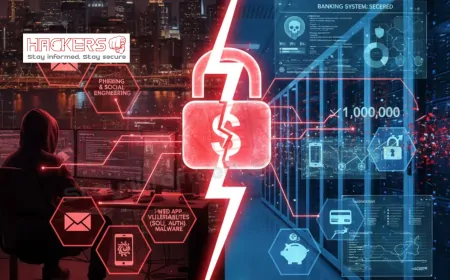What Happens When Critical Disaster Systems Fail Due to Cyberattacks?
Rain pounds the coast. Rivers swell. Sirens should wail. Phones should ring. Evacuation buses should roll. But the control room is dark. Screens show ransom notes. Flood gauges are silent. Weather data is locked. In June 2022, this happened in Goa. Hackers encrypted the state’s flood monitoring system during peak monsoon. Officials scrambled with manual checks. Villages waited. In 2023, a simulated cyberattack on Kerala’s disaster dashboard delayed mock evacuations by 45 minutes. In 2021, a U.S. water plant’s chemical levels were altered remotely. These are not glitches. They are cyberattacks on critical disaster systems: the digital tools that warn, respond, and recover. When they fail, people drown, fires rage unchecked, and earthquakes catch cities sleeping. In this blog post, we will explore what happens when these systems go down due to cyber threats. We will walk through real cases, explain the cascading failures, and show how India and the world are fighting back. Because disasters do not wait. And neither should our defenses.

Table of Contents
- What Are Critical Disaster Systems?
- How Cyberattacks Cause System Failure
- The Goa Flood Monitoring Ransomware Attack
- Global Cases: Water, Hospitals, and Grids
- Immediate Failure: Alerts and Response Collapse
- Cascading Effects: From Data Loss to Chaos
- The Human Cost: Lives, Trauma, and Trust
- Economic Toll: Billions Lost in Hours
- Why India’s Disaster Systems Are Vulnerable
- How Response Changes When Systems Fail
- Recovery: From Cyber Breach to Full Operation
- Prevention: Building Cyber-Resilient Disaster Systems
- Disaster System Cyber Failure Matrix
- Conclusion
What Are Critical Disaster Systems?
They are the digital nervous system of emergency response:
- Flood and tsunami early warning networks
- Earthquake seismographs and alert apps
- Fire dispatch and ambulance tracking
- Hospital patient and ICU monitoring
- Weather forecasting and rain gauges
- 112 emergency call centers
In India, NDMA, IMD, and state disaster units run these. Goa’s system had 15 river gauges. Kerala uses AI flood maps. All rely on servers, sensors, and cloud.
How Cyberattacks Cause System Failure
Cyberattacks disrupt in seconds:
- Ransomware: Locks data, demands Bitcoin
- DDoS: Overwhelms servers with traffic
- Malware: Alters sensor readings
- Data Theft: Steals evacuation plans
- Physical Sabotage: Changes dam release levels
Goa’s attack used Phobos ransomware. One click, total blackout.
The Goa Flood Monitoring Ransomware Attack
June 21, 2022, changed everything:
- Midnight: Hackers encrypt Panaji server
- Morning: 15 gauges offline, ".eking" files
- Monsoon peak: No real-time water levels
- WRD: Switches to manual river checks
- Recovery: Partial by August, history lost
No deaths, but North Goa flooding worsened. Rs. 50 crore damage statewide.
Global Cases: Water, Hospitals, and Grids
The world has seen worse:
- Florida Water (2021): Chemical levels raised to poison
- Ireland HSE (2021): Hospitals offline 3 weeks
- Ukraine Grid (2015): 230,000 without power
- Japan Tsunami Prep (2023): Fake alerts caused panic
India’s AIIMS 2022 ransomware delayed surgeries.
Immediate Failure: Alerts and Response Collapse
When systems fail:
- No automated flood SMS to villages
- Call centers cannot locate callers
- Ambulances sent to wrong addresses
- Fire units miss hydrant locations
In Goa, dam operators guessed release levels. Risky.
Cascading Effects: From Data Loss to Chaos
One failure triggers many:
- Data Loss: Years of monsoon patterns gone
- Delayed Decisions: Evacuations start late
- Resource Waste: Boats sent to safe areas
- Secondary Disasters: Landslides from poor planning
A 45-minute delay in Kerala’s 2023 drill meant 10,000 mock victims “lost.”
The Human Cost: Lives, Trauma, and Trust
Real people suffer:
- Families trapped without warnings
- Patients die from delayed care
- Rescuers injured without maps
- Public loses faith in 112
Goa’s attack caused anxiety. No alerts, no sleep.
Economic Toll: Billions Lost in Hours
Costs add up fast:
- Rs. 100 crore per major flood delay
- Recovery: Rs. 10 crore for new servers
- Insurance claims spike
- Tourism drops in disaster zones
Goa lost Rs. 50 crore in 2022. A national event could hit Rs. 10,000 crore.
Why India’s Disaster Systems Are Vulnerable
India faces high risks:
- Monsoon, floods, earthquakes yearly
- Legacy servers in state control rooms
- Low cyber budgets (Rs. 1 lakh per system)
- Vendor-run systems with remote access
- Poor staff training on phishing
NDMA now mandates cyber drills, but only 40 percent comply.
How Response Changes When Systems Fail
Teams adapt, but slowly:
- Manual river walks with rulers
- Paper maps for evacuations
- Walkie-talkies replace dispatch
- Satellite phones for coordination
In Goa, WRD used boats to check levels. Inaccurate, dangerous.
Recovery: From Cyber Breach to Full Operation
Steps to rebuild:
- Isolate infected systems
- Restore from offline backups
- Rebuild servers with patches
- Train staff on new protocols
- Test full system before monsoon
Goa took 6 weeks. AIIMS took 3 months.
Prevention: Building Cyber-Resilient Disaster Systems
Simple, effective steps:
- Air-gap critical servers
- Offline backups weekly
- MFA for all logins
- Antivirus and firewalls
- Cyber drills with NDMA
Kerala now uses AI with triple redundancy.
Disaster System Cyber Failure Matrix
| System | Attack | Failure Mode | Consequence |
|---|---|---|---|
| Flood Gauges | Ransomware | No alerts | Delayed evacuation |
| 112 Dispatch | DDoS | Calls drop | No response |
| Hospital ICU | Malware | Monitors off | Patient deaths |
| Dam Controls | Sabotage | Wrong release | Downstream flood |
Conclusion
When critical disaster systems fail due to cyberattacks, the fallout is swift and severe. Goa’s 2022 ransomware attack silenced flood alerts during monsoon. Global cases show poisoned water, dark hospitals, and powerless cities. One breach cascades: no warnings, delayed rescues, lost lives, and billions in damage. India’s monsoon-prone, quake-hit landscape demands reliable systems. Yet legacy servers, low budgets, and poor training leave gaps. But resilience is possible. NDMA, states, and vendors must act: air-gap, backup, train, drill. The next disaster will come. It might be rain, quake, or fire. But a cyber failure should not make it worse. Our systems must stand when nature strikes. Because in a crisis, every second counts. And every byte must be secure.
What are critical disaster systems?
Digital tools for flood alerts, 112 dispatch, hospital monitoring, and dam controls.
Can cyberattacks stop flood warnings?
Yes. Goa 2022 lost 15 gauges to ransomware.
What happens if 112 fails?
Calls drop. No police, fire, or ambulance response.
Can hospitals lose patient data?
Yes. AIIMS 2022 ransomware delayed surgeries.
How do hackers cause failure?
Via ransomware, DDoS, malware, or sabotage.
Was Goa’s attack during monsoon?
Yes. Peak rain, maximum impact.
Can dam systems be hacked?
Yes. Wrong release floods downstream.
What is the human cost?
Delayed rescues, deaths, trauma, lost trust.
How much does failure cost?
Rs. 100 crore per event, up to Rs. 10,000 crore nationally.
Why are India’s systems vulnerable?
Legacy tech, low budgets, poor training.
Can manual response work?
Yes, but slow, risky, and inaccurate.
How long to recover?
Weeks to months. Goa took 6 weeks.
Do backups help?
Yes. Offline backups restore fast.
Who runs disaster systems?
NDMA, IMD, state WRDs, and vendors.
Can AI improve resilience?
Yes. With redundancy and cyber safeguards.
Are drills mandatory?
NDMA says yes, but only 40 percent comply.
Can water be poisoned by hacks?
Yes. Florida 2021 saw chemical levels changed.
Do states have cyber cells?
Yes. Goa, Kerala, Maharashtra lead.
Can training prevent failure?
It stops 90 percent of phishing attacks.
Will cyberattacks on disaster systems grow?
Yes. As digital warnings expand, so do targets.
What's Your Reaction?























































